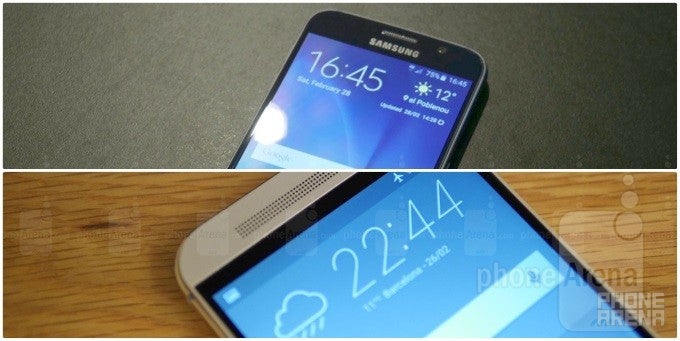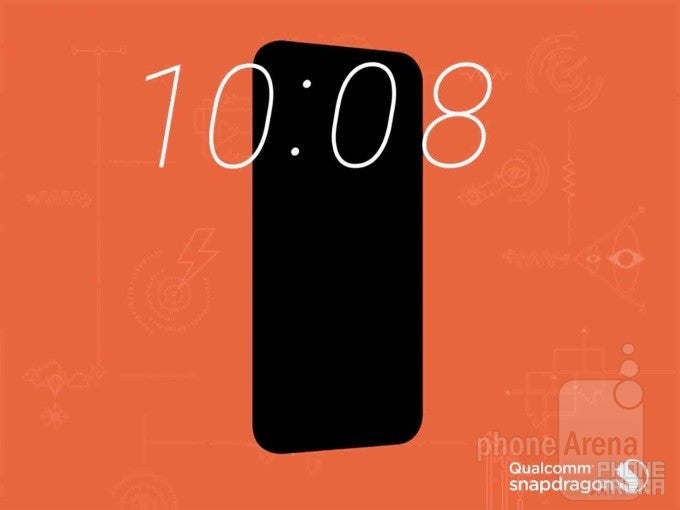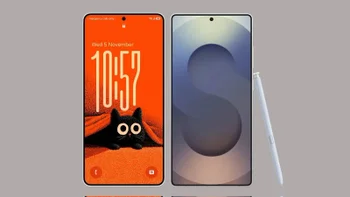HTC One M9 vs Samsung Galaxy S6: in-depth specs comparison

Design
The Samsung Galaxy S6 is a showcase of metal and glass that certainly looks very alluring to the eye. It upgrades the Galaxy S series' immediately recognizable, and often copied look with a blend of premium materials that redefines the devices' look for an age in which cheap plastic no longer cuts it for the average user. The Galaxy S6 measures 143.4 x 70.5 x 6.8mm and weights in at 138g, making for a thin and portable device, despite its sizeable display. It's also one of the few smartphones remaining to have a physical Home button below the display. Tradition and a fingerprint reader to empower a new payment system - that's two solid reasons for keeping the Home button around!
To face against this formidable foe, the HTC One M9 relies on the same stunning good looks that happened to define HTC's all-metal design as iconic. Simply put, there's no other Android flagship which comes close to that machined aluminum look - so pure, it doesn't have a shard of glass on it! In addition, the HTC One M9 flaunts a pair of stereo speakers that make it a much better boombox than the Galaxy S6 ever hoped to be! Dimensions-wise, the HTC One M9 measures 144.6 x 69.7 x 9.61mm and weights in at 157g, making it a heavyweight contestant in comparison with the Samsung Galaxy S6.
Display
To make another fine example of its display manufacturing prowess, Samsung chose to outfit the Galaxy S6 with a 5.1-inch 1440x2560 resolution AMOLED display which racks up an outrageous pixel density of 576PPI. It looks stunning in person, but so does the HTC One M9 with its 5-inch 1080p screen (441 pixels per inch) which sets the GS6's as complete overkill. But let's not argue over this tired case again. Until we get the chance to run our display tests and compare numbers, rest assured that both fantastic flagships come with brilliant displays that will put a whole world's worth of color and light underneath your fingertips.
Processor and memory
Both the Samsung Galaxy S6 and the HTC One M9 showcase the best of 2015's processing technology. In the former's case, a Samsung-made Exynos 7420 octa-core SoC runs the main parade, paired with a hearty 3GB of LPDDR 4 RAM. In addition, Sammy threw in UFS 2.0 flash storage that's touted as being 2.7 times faster than what most smartphones - the HTC One M9 included - currently have at disposal. In the Galaxy S6, you will find either 32, 64, or 128GB of the stuff, but you can't add more via microSD.

As for the M9, this one's a Qualcomm-powered beast in entirety, running on the US chip-maker's latest Snapdragon 810 octa-core silicon, and paired with 3GB of RAM. It also has 32GB of expandable storage on tap.

Interface
The Samsung Galaxy S6 runs Android 5.0 Lollipop skinned with the South Korean maker's renowned TouchWiz UI. Samsung refined the interface for its 2015 hero phone, opting to further simplify its once confusing menus and come up with a cohesive design language. While traces of TouchWiz's troubled past will remain for some time to come - it's no easy task designing something as complex as an user interface inside a huge company - Samsung noticeably tightened the skin and brought upon a welcome improvements in aesthetics, navigation, and response speed. Comparing the latest TouchWiz to the one we may recall from the Galaxy S4 and the Galaxy Note 3 is like comparing night - a rough one, at that - and day.
How does TouchWiz compare to the new Sense 7, though? Well, although they both worship the modern flat style, the two are vastly different. HTC has a very clear concept for its user experience, and its approach to functionality is less "let's please everyone" and more "let's give everyone something to remember". You remember BlinkFeed and Zoe, right? Well, they are coming back, and so are those beautiful menus whose response speed rivals that of iOS on the iPhone 6. In the end, both the Samsung Galaxy S6 and the HTC One M9 provide a rich and modern user experience. And if there's something about them that irks you, feel free to personalize the UI to your heart's content thanks to Samsung and HTC's newfound appreciation for extensive theming, or switch to a completely different launcher. Your call!
Finally, let's not forget about the Samsung Galaxy S6's fingerprint reader and heart-rate sensor - two nuggets of additional functionality that the HTC One M9 does not offer.
Camera
The comparison becomes really interesting here! For starters, although those 20MP camera rumors didn't pan out for the Samsung Galaxy S6, the phone came out with a respectable 16MP flash unit that, at the very least, should be able to match the Galaxy Note 4's wonderful daylight and low-light performance. The camera sensor also has extras such as Auto Real-time High Dynamic Range, Smart Optical Image Stabilization, and IR Detect White Balance, which combined, will provide a superb photography experience.
However, the HTC One M9 comes more than well prepared to brawl the Samsung Galaxy S6 in our of our camera comparisons! Waving a final goodbye to the UltraPixel camera and relocating it to its new duty as a selfie snapper, HTC dealt away with duo-cam gimmicks as well, and did what the people were longing for - it placed a huge 20MP camera on the M9's back. Now that's what we call making amendments! This cam has it all - sapphire cover lens, big f/2.2 aperture to make the most of the available light in dark situations, and a camera app to die for! In addition, both flagships shoot 4K video like they invented it.
Battery life
The Samsung Galaxy S6 will have to make do with a 2550mAh battery, which seems just a little bit wimpy considering the sharp screen and fast processor that shall prey upon its electrons! But we will draw our conclusions after we put the Galaxy S6 through our proprietary battery test. We're actually optimistic, as we saw Samsung do wonders with the specs-intensive Galaxy Note 4, which lasted longer than a workday of non-stop on-screen action.
As for the HTC One M9, its thicker build allowed for a bulkier 2840 mAh unit. We have very optimistic expectations towards its battery life, because the smartphone has a less power-hungry screen, while benefiting from a modern processor and a sufficiently large battery unit.
Expectations
With wide availability across major US carriers, retailers, and a global release, we expect both the Galaxy S6 and HTC One M9 to sell like hotcakes! Both are very attractive, well-rounded smartphones that are worth your hard-earned cash if you're after the best Android experience and nothing else. The Galaxy S6 will start selling in April, while the HTC One M9 could come a bit earlier - you might be able to snag one by mid-March already, if all the cards line up right. So, which one's your pick?
Follow us on Google News












Things that are NOT allowed:
To help keep our community safe and free from spam, we apply temporary limits to newly created accounts: